Malaysia to play major role in international aerospace industry with Asia Aerospace City (AAC)
Asia Aerospace City (AAC) is a bold, strategic initiative to catapult Malaysia into a major role in the international aerospace industry, which is expected to grow to over USD$1 trillion by 2020.
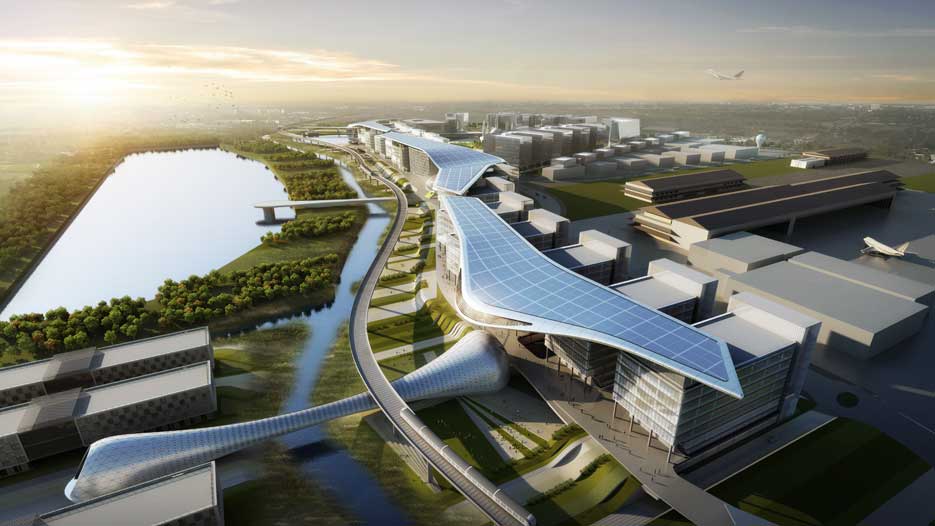
Asia Aerospace City (AAC) is a bold, strategic initiative to catapult Malaysia into a major role in the international aerospace industry, which is expected to grow to over USD$1 trillion by 2020. AAC is an aerospace hub that serves to combine the capabilities, assets and aerospace players worldwide with the opportunity for growth in Asia, with Subang nexus serving as the foundations of its physical infrastructure. It is conceived as a “smart city”—a vast integrated complex that is part academic campus, part business park, incubation and innovation center, research and technology park, virtual reality and pilot testing facility, residential space, and convention center.
To its participants and sponsors, AAC is intended provide a platform for seamless interaction between academic institutions and industry players, and to set the global aerospace standard for connecting aerospace players worldwide with the opportunity for growth in Asia.
The Subang nexus site has a total area of 19.8 acres with a view to expand and include an additional area of 56 acres, which is owned by Malaysia Airports Holdings Berhad (MAHB). The core site is located about 23km due south-west of the city centre of Kuala Lumpur. It adjoins the Sultan Abdul Aziz Shah Airport (SAAA), Subang and lie alongside the northwestern flank of Jalan Lapangan Terbang Subang within Section U3, Shah Alam, in the Mukim of Sungai Buloh, District of Petaling, State of Selangor Darul Ehsan. SAAA was the main airport serving Kuala Lumpur before the opening of Kuala Lumpur International Airport (KLIA) in 1998, now known also as the Subang nexus, it serves as the main hub for Firefly and Berjaya Air, as well as a major regional centre for aerospace maintenance, repair, and overhaul (MRO) operations, and many engineering firms. Companies can participate in the AAC and receive the services independent of being based in the Subang nexus, but the nexus offers many advantages. There are plans to develop other sites under the AAC branding. The nexus serves as the foundations of AAC’s physical infrastructure.
The world famous architecture and engineering firm of Atkins Global, atkinsglobal.com, (Atkins) (which designed the iconic 125-storey Anara Tower in Dubai, as well new cities in China) was contracted to design the Subang nexus. In July 2014 Atkins released its plan, which is truly stunning in conception and design. The design takes its cue from the wings of an aeroplane, and shows a 328,000 sq m (3,500,000 sq ft) development plus an additional 36,000 sq m (387,000 sq ft) for canopies to provide shade for the external areas. Atkins uses Computational Fluid Dynamics (CFD) analysis to ensure that natural breezes stream throughout the communal outdoor areas.
The plan features a fully-pedestrianized campus supplemented with a flow of electric buses though the development. Connections with the outside will be provided by a planned light railway station within walking distance. By rail, Subang nexus will be 20 minutes from Kuala Lumpur city center, 40 minutes from Kuala Lumpur International Airport and 5 minutes from Subang Airport.
The key functions of the development are arranged in clusters; an academic node with the Malaysian Institute of Aviation Technology and a 2,000-student capacity; a professional development centre; a research and training centre; an event node with a convention centre, business hotel and various event functions; and supporting infrastructure including restaurants, leisure amenities, and social spaces.
AAC envisages six strategic business units: business consulting centre, engineering services, professional development centre, research and technology, investment, and infrastructure.
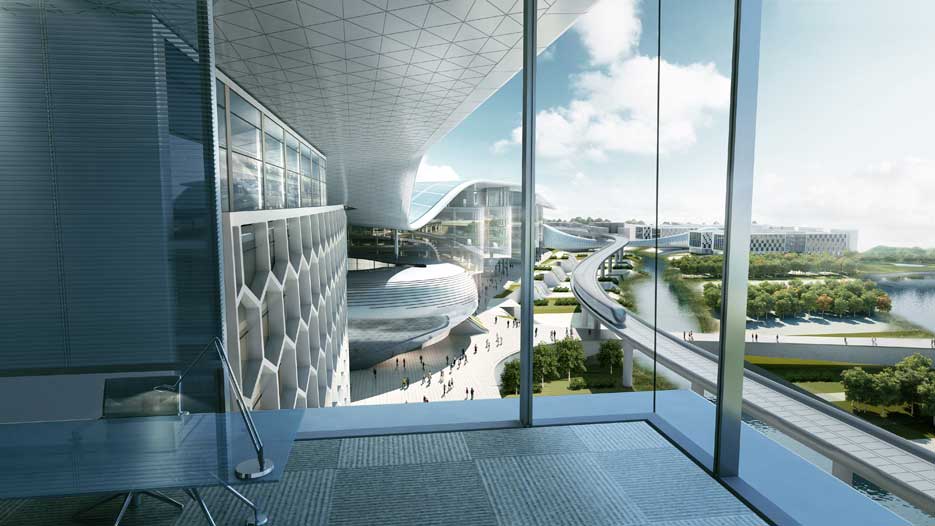
Ownership and Management
AAC is owned by Majlis Amanah Rakyat (MARA) —“The Council of Trust for the People,”—a Malaysian government agency for education and entrepreneurship under the purview of the Ministry of Rural and Regional Development. MARA has been developing Malaysian human capital since 1967 and supplies no less than 30% of the nation’s human capital.
MARA operates AAC through its fully owned subsidiary, MARA Aerospace & Technologies Sdn Bhd (M-AeroTech), while Pelaburan MARA, which was established on June 24, 1967 as an investment arm of MARA and is principally involved in strategic investment and fund management activities, will provide its international expertise and profound local know-how to help unlock more opportunities in the market in the future.
AAc’s Uniqueness
AAC is unique in two respects. First, its first completely integrated site provides the connectivity of every aspect of the aerospace industry in one location. In this respect, it may be said that AAC’s Subang nexus intends to be the equivalent of a “Silicon Valley” to the aerospace industry in the Asia/Pacific region. In a word, AAC will be the region’s source of concentrated expertise and innovation.
AAC thus offers a complete business ecosystem through its high-quality engineering services, industry-relevant human capital, iconic infrastructure, and government support. To the largest Original Equipment Manufacturers (OEMs) in the world, it is a competitive hub for industrial talent, cost efficiency, connectivity, and resources.
Background
Malaysia has long had a special place in its heart, and in its plans for the development of the aerospace industry. Former Prime Minister Matathir Mohammed, who led the nation for twenty-two years from 1981 to 2003, was a champion of bringing aerospace activities to Malaysia, as well as encouraging aerospace education. In 1997, he oversaw the promulgation of the first National Aerospace Blueprint, which set Malaysia’s aerospace industry on the path to become a global player by 2015. In 1998, when the new Kuala Lumpur International Airport (KLIA) was opened, prime minister Matathir immediately proposed that the airport it replaced, Sultan Abdul Aziz Shah Airport in Subang, be designated the Malaysia International Aerospace Center (MIAC).
Over the next decade-and-a-half, Malaysia attracted a multitude of aerospace companies and activities, including Airbus, Rolls Royce, and Spirit Aerosystems. Meanwhile, the Sultan Abdul Aziz Shah airport in conjunction with MIAC grew into a major regional airport known as Skypark, as well as a major international hub for aircraft maintenance, repair, and overhaul (MRO).
By 2013, it was time for Malaysia to move to the next stage. All indications were that the aerospace industry in the Asia/Pacific region was set to grow at a pace faster than the rest of the world market. It is forecast that by 2020 forty percent of all passenger aircraft sales will be in Asia, and that the European Aeronautic Defense and Space Company (EADS) plans to spend up to US$250 million in Malaysia by 2020 according to Rural and Regional Development Minister Datuk Seri Mohd Shafie Apdal.
It is further expected that the Asis/Pacific region will need 13,000 new airplanes valued at US$1.9 trillion over the next decade, and that aerospace industry will generate 10,000 engineering positions worth US$500 million (RM 1.5 billion) for engineering services in addition to those for maintenance, repair, and overhaul.
A decision was therefore made that the time was ripe for Malaysia to aggressively seek to capitalize on this growing market for aerospace services. The dream had long existed for Malaysia to become the hub for aerospace activities in the Asia/Pacific region, and the long developed educational efforts of MARA had led to a plethora of academic programs graduating 20,000 engineers annually from Malaysia’s universities.
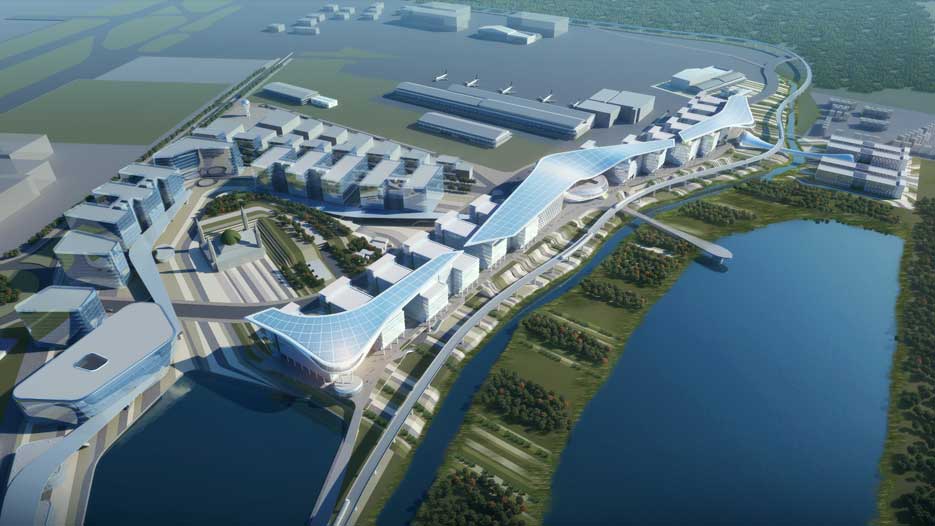
AAC’s Malaysia Debut
Thus, on March 4, 2014, the first announcement was made in Malaysia that MARA would establish AAC under the Edu-biz park concept to focus on the aerospace engineering services business.
Pelaburan MARA was designated take a lead role as the master developer. Pelaburan MARA was established on June 24, 1967 as an investment arm of MARA and is principally involved in strategic investment and fund management activities. It will lead the financial development of the project, while M-AeroTech will be the operational driver of the project.
At the same time, it was announced that Atkins Global, the world’s leading design, engineering and project management consultants, was contracted to act as lead consultant and master planner to provide the design and planning in relation the site development.
The Pieces Quickly Come into Place
Two days later, on March 17, 2014, Skyvax Sdn Bhd (SKYVAX), a local Malaysian company providing aviation related services in the area of pilot training in conjunction with the Czech Aviation Training Centre CATC, through its subsidiary Skyvax Simulators Sdn Bhd (Skyvaxsim), has committed to investing RM 300 million for 100,000 sq ft to locate its pilot training facilities, inclusive of eight Full Flight Simulators in the nexus. The company aspires to become the first full-fledged independent Authorized Training Organization (ATO) in the Asia/Pacific region.
On March 19, 2014, the Aereospace Malaysian Innovation Centre (AMIC) signed an MoU with M-AeroTech to establish AMIC’s Virtual Reality Immersive System for Training in Aerospace Manufacturing (VIRISTAM) in the Professional Development strategic cluster of AAC. AMIC is the key organization in exploring areas of growth for the Malaysian aerospace industry. M-AeroTech expects that “virtual reality trainings are going to make a big part of our training offerings in the future,” said Zulfikri Osman, executive director of M-AeroTech.
On June 13, 2914, MARA signed a memorandum of understanding (MoU) with Glyndwr University of Wrexham, Wales (UK) to collaborate on the Professional Development Center (PDC) Programme, which is one of the six offerings of AAC. Glyndwr, one of the three top universities in Wales, also agreed to open an engineering campus in Malaysia.
AAC’s International Debut
On July 15, 2014, AAC launched its international debut at the Farnborough Airshow in Hampshire, England, the biggest annual event on the aerospace industry’s calendar, which lasts seven days and combines a major trade exhibition for the aerospace and defence industries with a public airshow. The announcement of AAC was quickly followed on July 16 by the release of the renderings of Atkins for AAC’s first site.
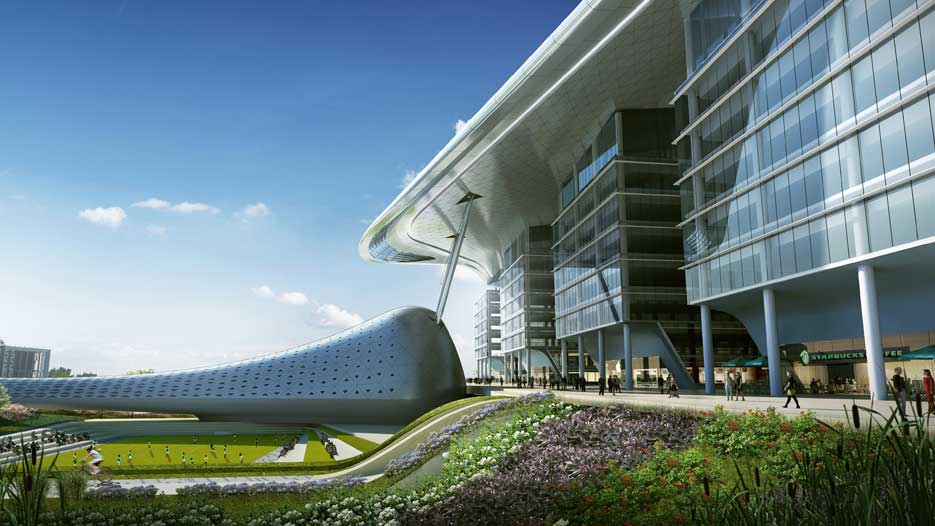
More Pieces Come into Place
Back in Malaysia, on July 17, 2014, the Aerospace Malaysia Innovation Centre (AMIC) agreed to lead the industry-led aerospace research and technology. Under the agreement, AMIC will connect AAC with global aerospace experts, starting with Airbus and Rolls Royce, members of AMIC, and then through its national and international research network. AMIC also signed a tripartite agreement with the University of Nottingham and AAC to team up on research and technology undertakings, especially on virtual reality, tooling and supply chain development, repair, and composite manufacturing. These activities will be housed in the German-Malaysian Institute (GMI) as part of AAC.
On July 18, 2014, immediately following the Farnborough Airshow, the University of Nottingham, East Midlands, England, UK, signed an agreement to collaborate with AAC and AMIC on research and technology, especially on virtual reality, and on tooling and supply chain development focusing on composite manufacturing, tooling, and manufacturing automation. The University of Nottingham, with 43,000 students, is the nearest Britain has to a truly global university. In 1999, Nottingham was the first British university to establish a campus overseas, when it opened a campus in Semenyih, Selangor, Malaysia.
On August 21, 2014, it was first publicly announced that AAC had received MSC status. MSC stands for Multimedia Super Corridor, Malaysia’s true “Silicon Valley of the East,” which stems from the tech city of Cyberjaya founded in 1999 as a new futuristic city to house the digital and multimedia industries of Malaysia. This means that AAC is not only tied into the aerospace industry, but also in the complete digital and multimedia world.
On September 2, 2014, the Aerospace Malaysia Innovation Centre (AMIC) went a step farther, and agreed to locate its physical centre in the AAC’s site.
On November 6, 2014, AAC officially launched its Research and Technology (R&T) Centre, though not at the AAC’s site in Subang, which is still under construction. Rather, the R&T Centre will be located at the campus of the German Malaysia Institute (GMI) in
Jalan Ilmiah, Taman Universiti, 43000 Kajang, Selangor.
AAC Phase I Completion
On October 23, 2014, AAC announced that the construction of Phase I is already 60% complete (excluding Phase 1 commercial area). The first phase will house AsiaAeroTechnic facilities, the second campus of Universiti Kuala Lumpur’s Malaysian Institute of Aviation Technology, whose first campus is located in Dengkil, Selangor.
The development of the AAC’s Subang nexus is divided into three phases. Construction of Phase 2 will begin at the end of 2017 or mid-2018, while the final phase will be constructed a few years later.
Phase 2 of the AAC’s site will feature a complete business ecosystem with facilities that include integrated offices, a knowledge centre, research and technology facilities and an academic campus. According to the Atkins plan, the development will boast 14 blocks having 15-18 floors of offices, a professional training centre and laboratories.
Phase 3 of the site will consist of a convention centre, a hotel and residential buildings. The convention centre will be used for aerospace exhibitions, conferences and educational events. The third phase of the development will also have retail outlets, a three-star business hotel, waterfront dining, an outdoor recreational centre, health and fitness facilities.
Upon completion, AAC’s site is expected to house hundreds of aerospace industry players and create 11,000 jobs for engineers alone along with two million sq ft of office space.
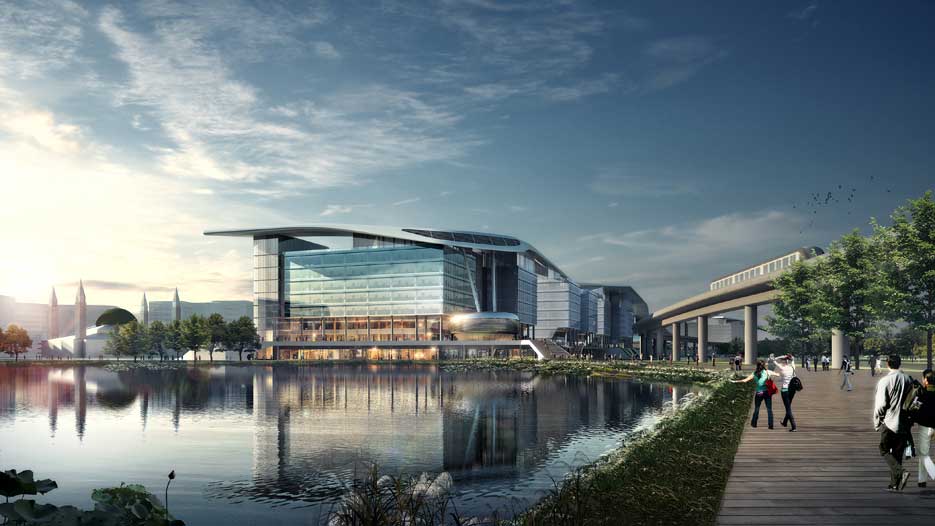
Summary
AAC is building a strong aerospace value supply chain framework to serve the requirements of enhanced manufacturing abilities and speed for Tier 1 organisations, under direct supervision from the OEMs.
M-AeroTech as a wholly owned subsidiary of MARA acts in line with the strategies of the Government of Malaysia. It is committed to invest in Key Strategic Partnerships towards continuous technology transfer and developing a supply value chain to support the aerospace manufacturers in a cost efficient and abled manner.
MARA through AAC, provides:
• Sustainable and industry-relevant human capital to address the competency gap experienced by the industry currently.
• Ease of doing business by facilitating business formation and smooth operation by offering business set-up solutions, coordination with and access to the relevant Malaysian Government’s agencies and authorities.
• Industry insights and information allowing analysis of market fundamentals, enabling companies to strategise for growth, leading to sound decisions
• Engineering Services supported by Strand Aerospace Malaysia offering high quality and affordable Engineering & Management Design, Analysis & Certification solutions. Delivering primary aero structures analysis covering; static, fatigue and damage tolerance, F&DT, finite element, composite, design, in-service support, and aircraft structural integrity for OEMs such as Airbus, BAE Systems, Spirit Aerosystems, Messier-Dowty-Bugatti etc.
• R&T: fully equipped and organised incubation facilities to research and bring technology preparedness, to support the growth of the Engineering & Management industry. This is through strategic OEM partnerships to ensure technology development is in line with global industrial needs, such as the partnership between Aerospace Malaysia Innovation Centre (AMIC), Airbus Group and Rolls Royce.